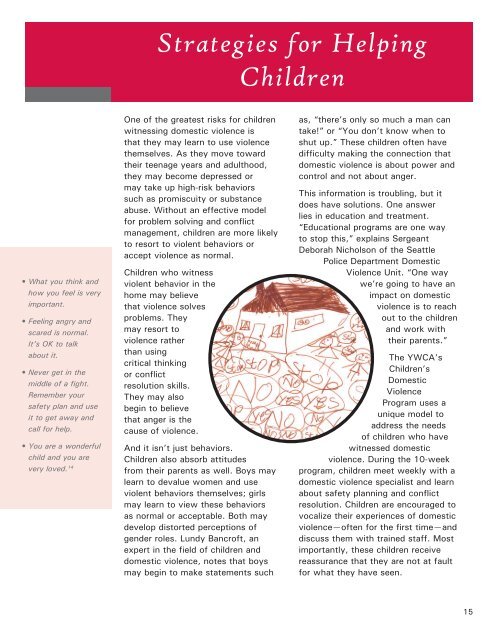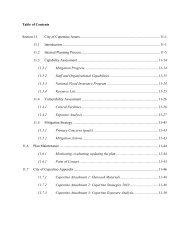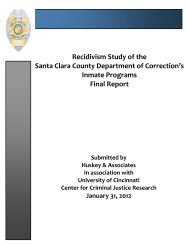Through Their Eyes: Domestic Violence and It's Impact on Children
Through Their Eyes: Domestic Violence and It's Impact on Children
Through Their Eyes: Domestic Violence and It's Impact on Children
You also want an ePaper? Increase the reach of your titles
YUMPU automatically turns print PDFs into web optimized ePapers that Google loves.
Strategies for Helping<br />
<strong>Children</strong><br />
• What you think <str<strong>on</strong>g>and</str<strong>on</strong>g><br />
how you feel is very<br />
important.<br />
• Feeling angry <str<strong>on</strong>g>and</str<strong>on</strong>g><br />
scared is normal.<br />
It’s OK to talk<br />
about it.<br />
• Never get in the<br />
middle of a fight.<br />
Remember your<br />
safety plan <str<strong>on</strong>g>and</str<strong>on</strong>g> use<br />
it to get away <str<strong>on</strong>g>and</str<strong>on</strong>g><br />
call for help.<br />
• You are a w<strong>on</strong>derful<br />
child <str<strong>on</strong>g>and</str<strong>on</strong>g> you are<br />
very loved. 14<br />
One of the greatest risks for children<br />
witnessing domestic violence is<br />
that they may learn to use violence<br />
themselves. As they move toward<br />
their teenage years <str<strong>on</strong>g>and</str<strong>on</strong>g> adulthood,<br />
they may become depressed or<br />
may take up high-risk behaviors<br />
such as promiscuity or substance<br />
abuse. Without an effective model<br />
for problem solving <str<strong>on</strong>g>and</str<strong>on</strong>g> c<strong>on</strong>flict<br />
management, children are more likely<br />
to resort to violent behaviors or<br />
accept violence as normal.<br />
<strong>Children</strong> who witness<br />
violent behavior in the<br />
home may believe<br />
that violence solves<br />
problems. They<br />
may resort to<br />
violence rather<br />
than using<br />
critical thinking<br />
or c<strong>on</strong>flict<br />
resoluti<strong>on</strong> skills.<br />
They may also<br />
begin to believe<br />
that anger is the<br />
cause of violence.<br />
And it isn’t just behaviors.<br />
<strong>Children</strong> also absorb attitudes<br />
from their parents as well. Boys may<br />
learn to devalue women <str<strong>on</strong>g>and</str<strong>on</strong>g> use<br />
violent behaviors themselves; girls<br />
may learn to view these behaviors<br />
as normal or acceptable. Both may<br />
develop distorted percepti<strong>on</strong>s of<br />
gender roles. Lundy Bancroft, an<br />
expert in the field of children <str<strong>on</strong>g>and</str<strong>on</strong>g><br />
domestic violence, notes that boys<br />
may begin to make statements such<br />
as, “there’s <strong>on</strong>ly so much a man can<br />
take!” or “You d<strong>on</strong>’t know when to<br />
shut up.” These children often have<br />
difficulty making the c<strong>on</strong>necti<strong>on</strong> that<br />
domestic violence is about power <str<strong>on</strong>g>and</str<strong>on</strong>g><br />
c<strong>on</strong>trol <str<strong>on</strong>g>and</str<strong>on</strong>g> not about anger.<br />
This informati<strong>on</strong> is troubling, but it<br />
does have soluti<strong>on</strong>s. One answer<br />
lies in educati<strong>on</strong> <str<strong>on</strong>g>and</str<strong>on</strong>g> treatment.<br />
“Educati<strong>on</strong>al programs are <strong>on</strong>e way<br />
to stop this,” explains Sergeant<br />
Deborah Nichols<strong>on</strong> of the Seattle<br />
Police Department <str<strong>on</strong>g>Domestic</str<strong>on</strong>g><br />
<str<strong>on</strong>g>Violence</str<strong>on</strong>g> Unit. “One way<br />
we’re going to have an<br />
impact <strong>on</strong> domestic<br />
violence is to reach<br />
out to the children<br />
<str<strong>on</strong>g>and</str<strong>on</strong>g> work with<br />
their parents.”<br />
The YWCA’s<br />
<strong>Children</strong>’s<br />
<str<strong>on</strong>g>Domestic</str<strong>on</strong>g><br />
<str<strong>on</strong>g>Violence</str<strong>on</strong>g><br />
Program uses a<br />
unique model to<br />
address the needs<br />
of children who have<br />
witnessed domestic<br />
violence. During the 10-week<br />
program, children meet weekly with a<br />
domestic violence specialist <str<strong>on</strong>g>and</str<strong>on</strong>g> learn<br />
about safety planning <str<strong>on</strong>g>and</str<strong>on</strong>g> c<strong>on</strong>flict<br />
resoluti<strong>on</strong>. <strong>Children</strong> are encouraged to<br />
vocalize their experiences of domestic<br />
violence—often for the first time—<str<strong>on</strong>g>and</str<strong>on</strong>g><br />
discuss them with trained staff. Most<br />
importantly, these children receive<br />
reassurance that they are not at fault<br />
for what they have seen.<br />
15
















